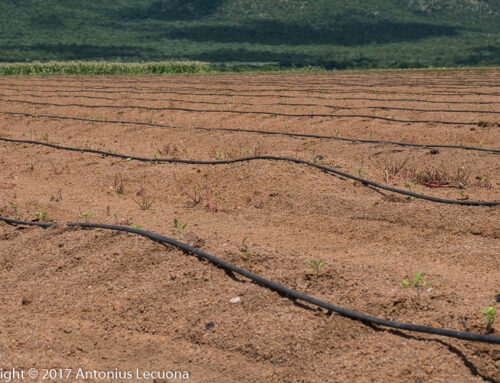Green bean micronutrients or trace elements are often a forgotten aspect, not just in green beans but in general vegetable farming. Micronutrient deficiencies are rare in green beans but there are some soils where symptoms can occur. What growers forget is that a very small amount can have a devastating effect on yields. That is why they are called micronutrients or trace elements. The plant absorbs minute quantities from the soil. You might add 10-15 bags of NPK fertilizer per hectare but you will hardly use a bag of micronutrients. As a matter of fact, foliar sprays are quite often very effective to alleviate micronutrient deficiencies. Micronutrients are often added to pest and disease control sprays. Micronutrients should be added before planting as they are often not very mobile and adding them to the soil during the growth season has not much effect. If you do detect some deficiency during the growth season, rectifiy it with a foliar spray and with the next planting, add sufficient before planting.
Let’s look at some trace elements and how to add green bean micronutrients.
Zinc (Zn)
A zinc deficiency is characterised by abnormally small leaves. The internodes are shorter resulting in small stunted plants and rosette-shaped flat crowns. If you suspect zinc deficiency add 10-20 kg/ha zinc oxide during the growth season. A zinc spray will also alleviate some symptoms but in most cases you have lost at least 30% of total potential yields.
Manganese (Mn)
Don’t confuse manganese (Mn) with magnesium (Mg). It will be devastating if you swapped the quantities around and added them to the soil. A green bean manganese deficiency is not common in South Africa. The plants show smaller than normal leaves with speckled yellowing between the veins. The veins stay green. Brown spots can occur and the deficiency is often confused with various fungal infections/symptoms. As a preventative measure 20-30 kg/ha manganese sulphate can be applied before the growth season. A foliar spray with soluble manganese fertilizer quickly rectifies the deficiency.
Boron (B)
A boron deficiency is characterised by a slight yellowing (mosaic pattern) of leaves and thickening of stems. Sometimes the stems split open and growth points die. The plants are inclined to form more than the normal amount of lateral sprouts, but these growth points also die off. 10 kg/ha commercial borax is recommended before growing season. If the previous crop received borax there is no need to apply any more. Be vigilant when inspecting the plants for any deficiency symptoms, and if some occur, add more borax during the growth season.
Copper (Cu)
Copper is an important trace element but deficiencies are hardly ever noted in green beans. Green beans have a high tolerance to low copper concentrations in the soil. This is possible due to its high efficiency in absorption or the relative short growth period. According to TISDALE et al. (1985)1)TISDAE, S.L., NELSON, W.L. & BEATON, J.D. 1985. Soil Fertility and Fertilizers. MacMillan Publishing Company, New York. p.364. low copper deficiency tolerance is caused by high rate of copper absorption, better root volume and length, better contact with soil by the roots such as root hairs etc., root exudate make more copper available for absorption and chemical alteration of the soil by the roots. The plant can also have a general lower requirement of copper than other plants.
Since many fungal diseases are controlled by copper sprays, there is no need to add additional copper to the soil or apply a foliar spray separately.
Notes on foliar sprays
Some notes on foliar nutrition. It is possible to apply green bean micronutrients to the plant via a foliar spray, but this is not the holy grail of plant nutrition. The worse the deficiency is the better the effect of the spray will be. Marginal deficiencies might not even alleviate any symptom in the field. So be careful when adding foliar sprays as it can be a waste of money. The best is to do a trial in a row where you suspect deficiencies and if no reasonable improvements is seen within 5-7 days, don’t spray any more.
References
| ↑1 | TISDAE, S.L., NELSON, W.L. & BEATON, J.D. 1985. Soil Fertility and Fertilizers. MacMillan Publishing Company, New York. p.364. |
|---|






Leave A Comment
You must be logged in to post a comment.